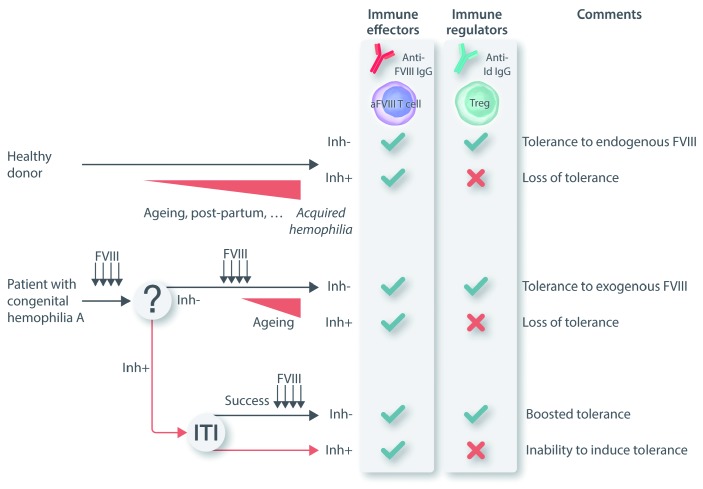Figure 1.
Immune recognition of factor VIII in health and disease. Healthy donors. At the humoral level, tolerance to factor VIII (FVIII) under physiological conditions relies on an equilibrium between the recognition of FVIII by naturally occurring potentially inhibitory anti-FVIII antibodies and their control by blocking anti-idiotypic antibodies. Blocking anti-idiotypic antibodies may also regulate B-cell clones that secrete FVIII-specific autoantibodies. At the T-cell level, natural FVIII-reactive T cells may be down-regulated by natural regulatory T cells (Tregs; i.e., CD4+CD25+FoxP3+ Tregs) and/or by induced transforming growth factor-beta-secreting Tregs. In rare cases, and in particular in aging individuals, tolerance may fail and a neutralizing immune response to endogenous FVIII may develop - a condition referred to as acquired hemophilia. Patients with congenital hemophilia A. Based on the available evidence, we propose that a similar equilibrium between FVIII-reactive and FVIII-protective immune elements guarantees tolerance to therapeutic FVIII in inhibitor-negative patients, either upon spontaneous induction of immune tolerance at the time of initiation of FVIII treatment (i.e., in 70-80% of patients with the severe form of the disease), or after a drastic boost of the immune system in patients undergoing successful immune tolerance induction (ITI) (i.e., in about 70% of inhibitor-positive patients with severe hemophilia A undergoing ITI). As is the case in healthy individuals, immune tolerance to FVIII may be lost upon aging.71 Of note, 10% of the patients (30% of the inhibitor-positive patients with severe hemophilia A in whom ITI fails) are not able to develop immune tolerance to FVIII, even after intensive desensitization protocols. Inh+: inhibitor-positive; Inh−: inhibitor-negative; ITI: immune tolerance induction; anti-Id IgG: anti-idiotypic immunoglobulin G; aFVIII T cell: factor VIII-reactive T cell.

